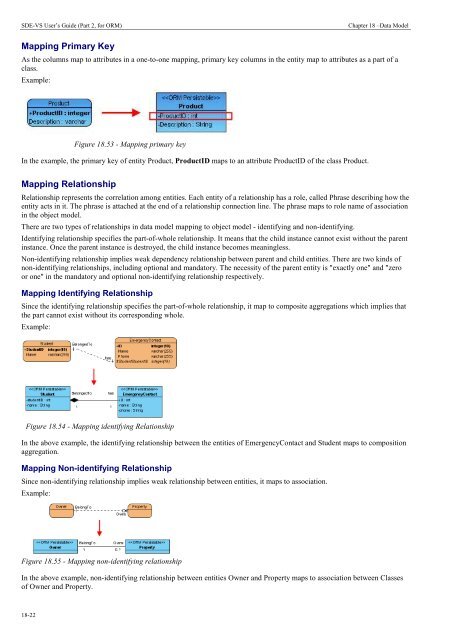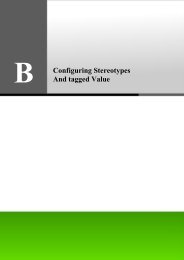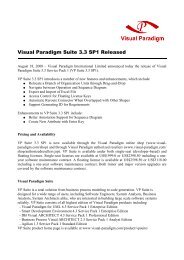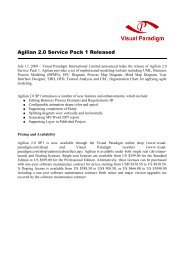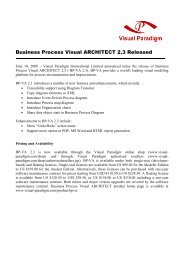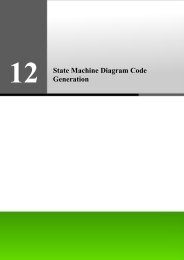Chapter 18 - Data Model - Visual Paradigm
Chapter 18 - Data Model - Visual Paradigm
Chapter 18 - Data Model - Visual Paradigm
Create successful ePaper yourself
Turn your PDF publications into a flip-book with our unique Google optimized e-Paper software.
SDE-VS User’s Guide (Part 2, for ORM) <strong>Chapter</strong> <strong>18</strong> –<strong>Data</strong> <strong>Model</strong><br />
Mapping Primary Key<br />
As the columns map to attributes in a one-to-one mapping, primary key columns in the entity map to attributes as a part of a<br />
class.<br />
Example:<br />
<strong>18</strong>-22<br />
Figure <strong>18</strong>.53 - Mapping primary key<br />
In the example, the primary key of entity Product, ProductID maps to an attribute ProductID of the class Product.<br />
Mapping Relationship<br />
Relationship represents the correlation among entities. Each entity of a relationship has a role, called Phrase describing how the<br />
entity acts in it. The phrase is attached at the end of a relationship connection line. The phrase maps to role name of association<br />
in the object model.<br />
There are two types of relationships in data model mapping to object model - identifying and non-identifying.<br />
Identifying relationship specifies the part-of-whole relationship. It means that the child instance cannot exist without the parent<br />
instance. Once the parent instance is destroyed, the child instance becomes meaningless.<br />
Non-identifying relationship implies weak dependency relationship between parent and child entities. There are two kinds of<br />
non-identifying relationships, including optional and mandatory. The necessity of the parent entity is "exactly one" and "zero<br />
or one" in the mandatory and optional non-identifying relationship respectively.<br />
Mapping Identifying Relationship<br />
Since the identifying relationship specifies the part-of-whole relationship, it map to composite aggregations which implies that<br />
the part cannot exist without its corresponding whole.<br />
Example:<br />
Figure <strong>18</strong>.54 - Mapping identifying Relationship<br />
In the above example, the identifying relationship between the entities of EmergencyContact and Student maps to composition<br />
aggregation.<br />
Mapping Non-identifying Relationship<br />
Since non-identifying relationship implies weak relationship between entities, it maps to association.<br />
Example:<br />
Figure <strong>18</strong>.55 - Mapping non-identifying relationship<br />
In the above example, non-identifying relationship between entities Owner and Property maps to association between Classes<br />
of Owner and Property.


